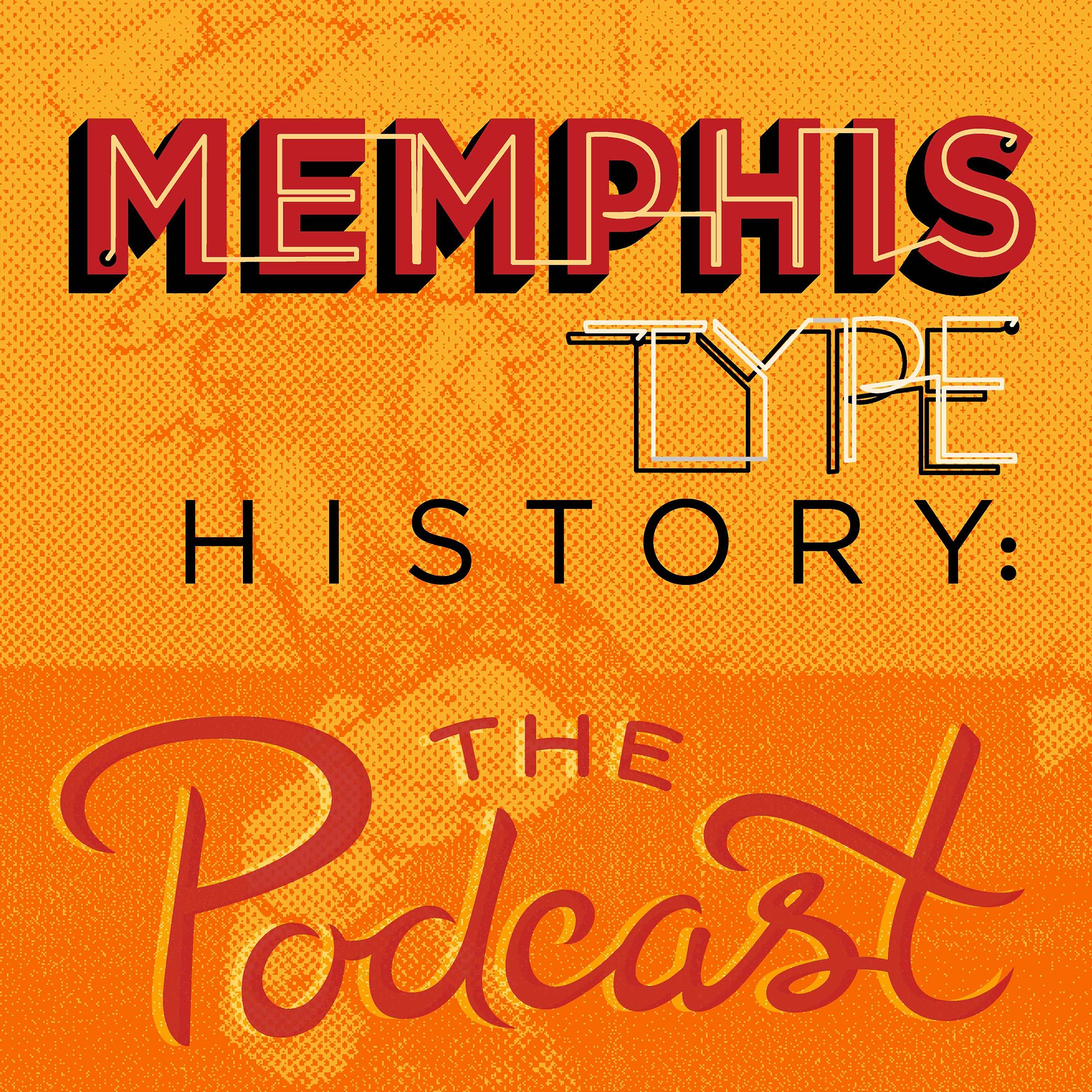Episodes
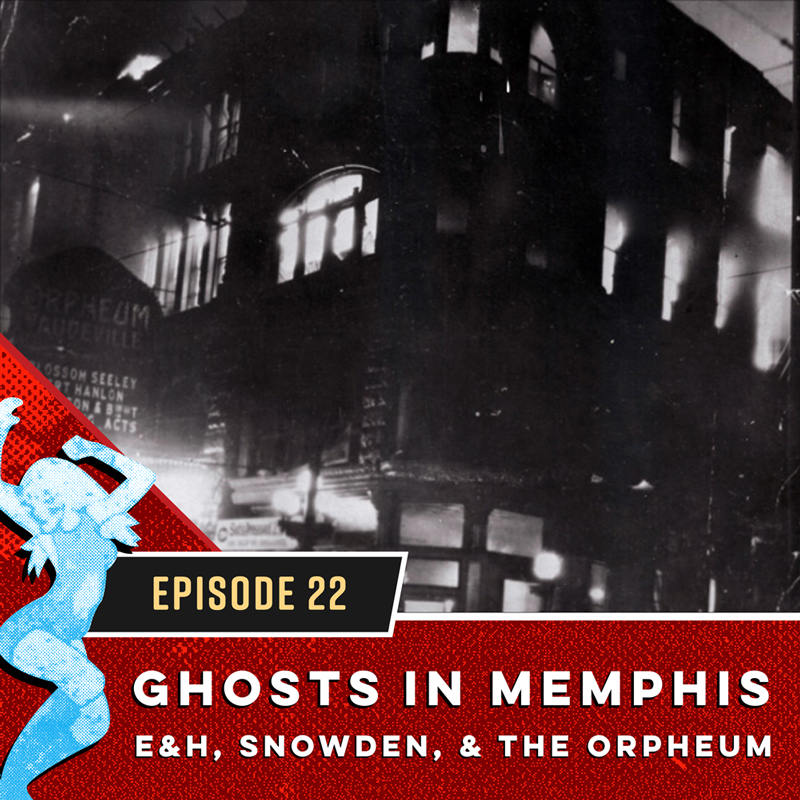
Monday Oct 30, 2017
Ghosts In Memphis: E&H, Snowden, & The Orpheum
Monday Oct 30, 2017
Monday Oct 30, 2017
In this episode of Memphis Type History: The Podcast, we learn that there are a lot of ghosts in Memphis. Earnestine & Hazels, Annesdale Snowden historical neighborhood, and The Orpheum Theater are just a few places where you can find a ghost. To get you further into the Halloween spirit, listen to first-hand accounts of encounters with these ghosts and discover if perhaps you've met one yourself!
Introducing the Pigman
First Caitlin sets the mood for this episode by sharing a story she uncovered of a past Memphis ghost who haunts a smoke stack in North Memphis... the PIGMAN! Squuueeeeeeeel.
The Haunting of Earnestine & Hazel's
But then things get real when we share a true story of a guy who witnessed a ghost first-hand at Earnestine & Hazels. We also hear two tales of things that go bump in the night from listeners – but one of them might have quite a logical explanation...
Ghosts Get Real in One Memphis Neighborhood
This house may look like an idealic southern home, but there is more hiding behind the bricks. Ashleigh Carroll shares how she discovered the home she purchased may actually be haunted. "Henrietta" has been paying visits to her family for years. Ashleigh tells several stories about her experiences with the ghost including how other people have at various times confessed experiencing paranormal activity without realizing Ashleigh already knew about it. And spookiest of all, perhaps, the mysterious messenger who delivered a bundle of very old photos of the previous residents only saying, "The pictures stay with the house." You can see a couple of those photos below but you'll want to listen to hear why its especially creepy.
Mary, The Orpheum's Longest Tenured Star
The Orpheum theatre is a historic place of entertainment. From broadway shows, to concerts, and various other performances, there aren't many dull nights at this theater. Well, we found out that is especially true because Mary (we're not sure why everyone names their ghosts, but seriously, they ALL have a name!) has been haunting this place since the 1920's. Her story is one of tragedy but her presence is warm and joyful. Whether it be a practical joke, hanging out with kids, or watching shows on the balcony, Mary is in good spirits. She even made her presence known to the star of The King and I while on stage. Interestingly, that same show just recently finished a run at the Orpheum. Curious about all the stories? We hear from the director of marketing for special productions, Renee Brame, about the various times and places people have experienced Mary's presence.
For full show notes, go to memphistypehistory.com/halloween17
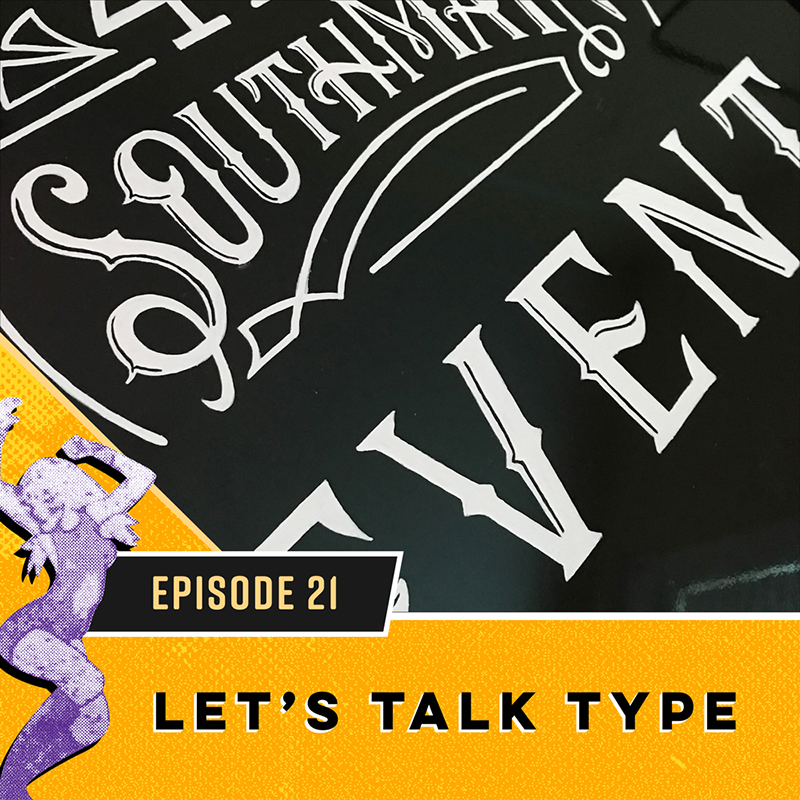
Sunday Oct 22, 2017
Let's Talk Type
Sunday Oct 22, 2017
Sunday Oct 22, 2017
In this episode of Memphis Type History: The Podcast, we're talking type – typography that is! Rebecca gets in the hot seat to teach us all about appreciating the visual form of words and letters... and how we can get more into typography in our everyday lives.
We dive right in to typography as it relates to signage and lettering in this episode. So we recommend that you first listen to our intro episode if you haven't already for a background on how Memphis Type History began and the double meaning in its name.
Typography is text, fonts... type is a letter form. Letter form is an art form that can be made digitally on the computer or by hand, and even through typesetting like on a letterpress where letters made out of wood or metal are used to create different prints. These days, endless type can be created, and even sold, using modern technology!
In the olden days, signs were typically hand-painted. What was painted on the side of the building to advertise what was inside often became the logo for the business... and this method continues today through Rebecca's own hand for businesses like Propcellar and 409 South Main.
What's needed to create good type? A sense of space, composition, and a steady hand for the most part. Hand-lettering involves researching an appropriate era for inspiration and figuring out how to merge these styles with what is appropriate for the project. Rebecca will often create several different options, which often creates an entirely different feel to the entire piece even if each ones is coming from the same inspiration.
To create her Florida piece, Rebecca first planned out the piece on paper. She decided how the letters should be spaced out, what style they should have, and whether they need flourishes or not... she even thinks about how thick or thin each part of the letter should be. Unlike pieces like the one below which Rebecca creates by painting layers upon layers, her typographic pieces are sketched out first.
Rebecca begins by sketching "roughs" onto paper. She keeps working and working until it's exactly how she wants. Then she transfers the sketch (usually smaller scale) onto the wood using carbon paper. Letters don't need the soft edges that a painting of a sign or a landscape needs to look realistic, so all she has to do is paint the background and then work on top of the carbon copy sketch. In order to hide the lines, Rebecca paints slightly over the edge of the carbon marks – as she pointed out, steady surgeon hands are surely needed!
If you want to get into typography, Rebecca recommends resources like Thinking with Type , Sign Painters , and take time to visit your local library.
For full show notes go to memphistypehistory.com/type
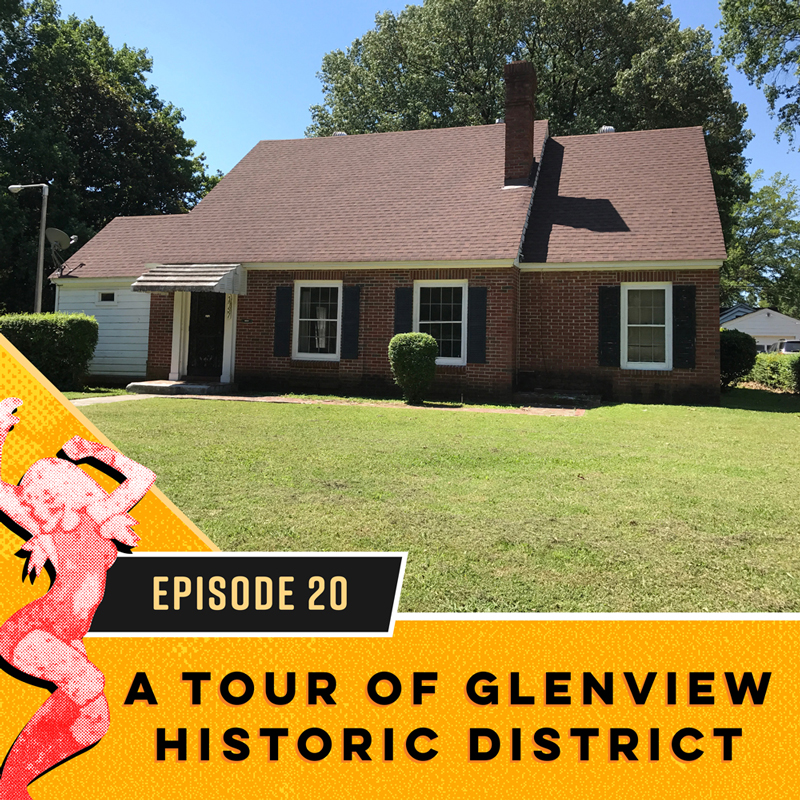
Sunday Oct 15, 2017
A Tour of Glenview Historic District
Sunday Oct 15, 2017
Sunday Oct 15, 2017
In this episode of Memphis Type History: The Podcast, Caitlin gives Rebecca an overview of the history behind Glenview Historic District. Then we sit down with Glenview resident Tramica Bridges who tells us all about the history of her home and so kindly gives us a tour!
In 1904, architect George E. Kessler began work on the Memphis Parkway system, part of the City Beautiful Movement which aimed to create a city that integrated well with nature. The plan included features like neighborhood parks as well as lampposts, benches, and other "street furniture." You can see aspects of this trend throughout Glenview, which was mostly built from the 1910s through the 1940s (although there are some homes that date up to 1997).
In addition, there are also curves in the grid layout of the neighborhood, a new development that came alongside the introduction of cars into everyday usage. Within the subdivision, you can find wonderful examples of architecture of this period, such as the bungalow, craftsman, Tudor revival, Spanish Colonial Revival, and your good ol' ranch homes, among others. This historic neighborhood is bordered by South Parkway East on the south, Burlington Northern Railroad on the west, Southern Avenue on the north, and Lamar Avenue on the east.
Glenview's first residents were white, middle class professionals – small business owners, salespeople, craftsmen, and the like. A notable event that once took place in the neighborhood was the staging of Tennessee Williams' first play, Cairo, Shanghai, Bombay! in 1935, when he was a student at Southwestern College, by the amateur theater group out of Alice G. Rosebrough’s home, aka "Rose Arbor."
In 1956, Reverend Charles H. (Bob) Mason, Jr., the pastor at the Church of God in Christ (one of the largest Pentecostal churches in the nation and the largest Pentecostal congregation in Memphis) purchased the house at 1755 Glenview Avenue. The Glenview Civic Club and the Glenview Plan, Inc. (a business scheme designed to purchase properties put on the market in the neighborhood and sell them only to other white people) began working to keep Mason, Jr. and other African-American families, out of the area. We discuss these disturbing dealings and the attempts to intimidate with various acts of violence further on the show.
Other black leaders made their home in Glenview, with 1968 being a turning point in the transition of the neighborhood. The National Guard occupied the neighborhood and imposed a curfew on black residents, which apparently signaled to the remaining white ones that outsiders considered the neighborhood to be a black one. So out they moved, making room for many extremely notable black leaders like the first African American writer for the Commercial Appeal, Rubye Coffman, the first black Memphis policeman, Memphis Red Socks players, and more.
Next on the show, Rebecca and Caitlin visit Tramica Bridges for a tour of her Glenview home. Her house has been featured in the Glenview home tour in previous years, and she takes great care to keep its historical elements while adding her own flair. We loved how her son, the entrepreneur behind Mo's Bows, also adds his own unique take to the space!
Tramica shares the history of her home's past owners, followed by a tour of the house.
For full show notes go to memphistypehistory.com/glenview
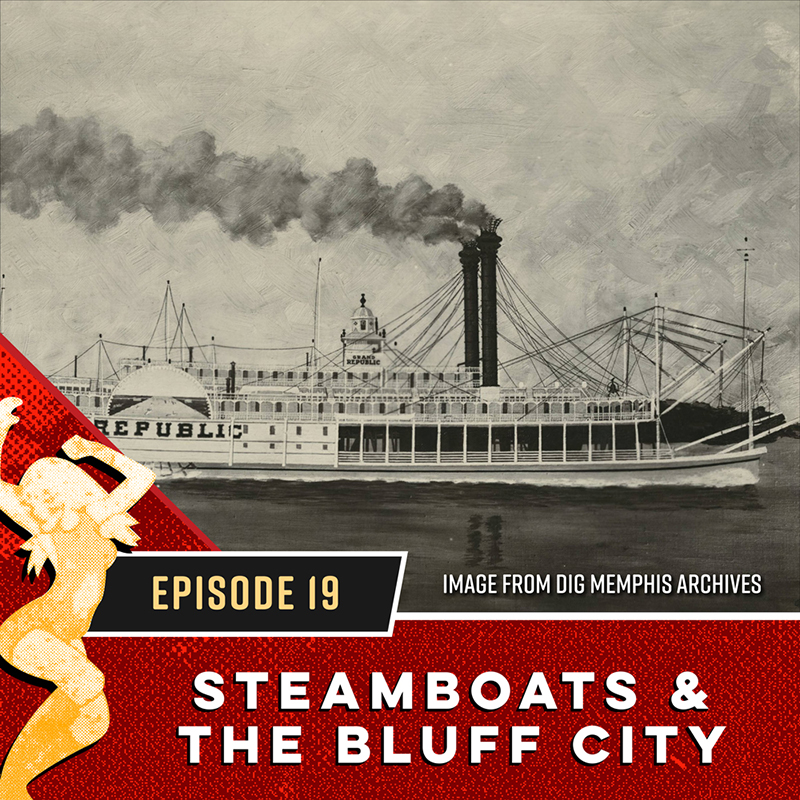
Sunday Oct 08, 2017
Steamboats and the Bluff City
Sunday Oct 08, 2017
Sunday Oct 08, 2017
In this episode of Memphis Type History: The Podcast, Caitlin and Rebecca get on a boat. No, that's wishful thinking. Instead, Caitlin tells Rebecca about the history of steamboats and how these ships played a role in the growth of Memphis.
This episode begins with an introduction to Caitlin's favorite steamboat captain, singer and songwriter John Hartford. Sure, he won three Grammy's for "Gentle on My Mind" but her preferred track is "Don't Leave Your Records in the Sun." Who doesn't love a good tip set to music?
Steamboats played a huge role in the economic growth of cities along the river, as well as the entire United States, in the early 19th century. These massive ships were able to take large amounts of freight and passengers both up and down the country's major rivers and tributaries due to the newfangled steam power technology.
The very first steamboat on the Mississippi River was The Orleans way back in 1811. It was launched from Pittsburgh and worked alright, but many design and technological improvements were quickly on their way. The boats that followed were named the Comet, the Vesuvius, the Enterprise, and the Washington. But only The Enterprise boldy went where no man had gone before.
By 1810, there were twenty steamboats on the river. At first they were made of wood and fueled by wood, but later that fuel became coal. At first, it took three weeks to make the trip up the Mississippi River to Ohio. But as time progressed and more powerful engines were constructed, better boiler systems came into play, pilots got more experienced, and dangers were removed from the river, this trip was cut down to just four days. Because of construction methods, fires, and frequent damage by obstacles along the river, a steamboat lasted, on average, about five years. By the 1830s, over 1,200 boats were chugging up and down the waterways.
Memphis became a prominent port out of its slave trade. This was one catalyst for the First Battle of Memphis on June 6, 1862, a naval battle that many citizens went out to watch. The Union won the battle, and Confederate naval control of the river was pretty much nonexistent after that. Tom Lee Park is located on the riverfront, and is named for an African American riverworker, who himself couldn't swim, rescued, on his own, 32 drowning people from sinking of the M.E. Norman in 1925.
So what was life like on a steamboat back in the day? Well, supposedly, beer was the #1 drink in the 1800s, also known as the glory days of the riverboat. There was a lot of gambling on the boats, and pilots often raced each other. There are several very famous races with well-known captains documented from history. These pilots were highly skilled, as they didn't have instruments and navigational readouts to go on. Instead, they learned from experience where the sandbars, rocks, snags, and landmarks were along the river. They also had to know about stuff that changed all the time, like river depth and current, and much of that was understood through understanding swirls, ripples, and what the color of water meant... and then pairing that knowledge with a gut instinct for the feel of the boat.
In the early 20th century, steamboat usage began to decline. Passengers began using a faster form of transportation – the train. Then came the Great Depression, which saw a decline in almost every industry. Shipbuilding technology had improved to where diesel engines were being used a lot more. Diesel tugs required smaller crews, which meant less wages. Plus, the technology was just better. So by the 1940s, steamboats were considered outdated.
These days, only a few riverboats still run on steam. According to research, the Belle of Louisville, the Natchez, the Minne-Ha-Ha, the Chautauqua Belle, the Julia Belle Swain, and the American Queen are still operating. In 2008, the U.S. government put an end to overnight passage on steamboats except with the permission of Congress.
In Memphis, you can still get out on the water on a riverboat. The journey begins on the cobblestone landing, built by immigrants from 1850 to 1890. It's presence made a big difference in Memphis becoming such a huge port city because it could withstand the mules loading and unloading all the heavy goods. As of 1996, it's estimated that more than 800,000 of the original cobblestones are still there, although it's all in great disrepair. It's the last complete stone landing on any waterfront in the country.
In the 1950s, most riverboat-related activities moved to President's Island. In 1955, the Memphis Queen Line was founded by Captain Ed Langford. In 1960, his part-time captain, Tom Meanley, purchased the company. He later endeavored to build the Memphis Queen III from 1977-1979, and then the Island Queen from 1982 to 1984, from the ground up. They made the hulls at Meanley Shipyard behind Captain Tom's house in Whitehaven, and then a house-moving company took them to McKellar Lake about 12 miles away. From there, they were towed to the cobblestone landing where the smokestacks, pilot house, and decks were added. You can ride the Island Queen, the Memphis Queen III, or the Memphis Showboat on sightseeing trips, dinner cruises, and private charters.
For full show notes, go to memphistypehistory.com/steamboats
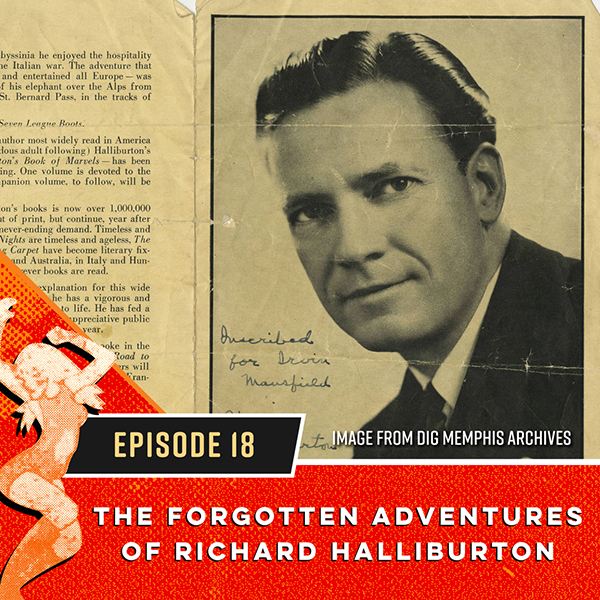
Sunday Oct 01, 2017
The Forgotten Adventures of Richard Halliburton with R. Scott Williams
Sunday Oct 01, 2017
Sunday Oct 01, 2017
In this episode of Memphis Type History: The Podcast, Rebecca sits down with R. Scott Williams to learn all about Richard Halliburton, a famous but forgotten Memphian. Halliburton cuts a fascinating figure in history as an explorer and adventure writer.
Scott, COO of the Newseum in Washington, D.C., published The Forgotten Adventures of Richard Halliburton. If the name sounds slightly familiar to you, it's because Halliburton Tower lies on the Rhodes campus, donated by Halliburton's father (along with documents from his life and travels). Fun fact: Halliburton's mother was one of the first psychologists in Memphis!
And now, onto the main event – Richard Halliburton.
“Let those who wish have their respectability. I wanted freedom, freedom to indulge in whatever caprice struck my fancy, freedom to search in the farthermost corners of the earth for the beautiful, the joyous and the romantic.” –Richard Halliburton
At the age of nineteen, Halliburton ran away from his hometown of Memphis to go on adventures. He became an internationally known celebrity and the most famous travel writer in the grand ages for adventure – the Golden Age, the Roaring Twenties, and into the Great Depression. He did everything from climb Mount Olympus to flying all the way to Timbuktu, always looking for the next bigger and more astounding adventure to share with the world.
But wait... how did he fund all this crazy travel? Well, back in the day, people gave lectures about the adventures they went on... and these events funded their subsequent adventures. He would do as many as 50 lectures a month sometimes! Basically he was the Anthony Bourdain before there was such a thing as the Travel Channel. If he lived today, he would be the ultimate travel brand... and Scott even tells us what his TV show would probably be called, but you'll have to listen to this episode to find out more!
Scott shares how Halliburton was a great marketer and could always find the best "hook" for designing adventures. In one instance, he decided to fly to his next adventure. He flew all over the world for 18 months, including into volcanoes! His pilot and he ran into another pilot, Elly Beinhorn, who was also quite adventurous in her own right. Oh, and Scott really thinks this period of Halliburton's life would make a great movie – and there's even a love story that makes that even more intriguing....
One of our favorite things was how tied to Memphis Halliburton was. For example, when Halliburton was but a toddler around 1902, Mary Hutchison, the founder of Hutchison School, started the school in his home, as she was great friends with his parents. "Hutchy," as she was known, was called "Grandmother" by Halliburton, and she's even buried in the family plot. She's credited with really giving him his spirit of adventure.
Unfortunately, Halliburton's last adventure was a bit too ill-conceived and he perished in a typhoon while sailing the seas in a Chinese junk. The original plan was for him to sail the junk from Hong Kong to San Francisco and appear just in time for the opening day of the World's Fair. However, he disappeared at sea at the age of 39... just two years after another famous adventurer, Amelia Earhart.
We hope finding out more about this amazing Memphian will revive an interest in writings and life's work of adventuring around the world.
For full show notes go to memphistypehistory.com/halliburton
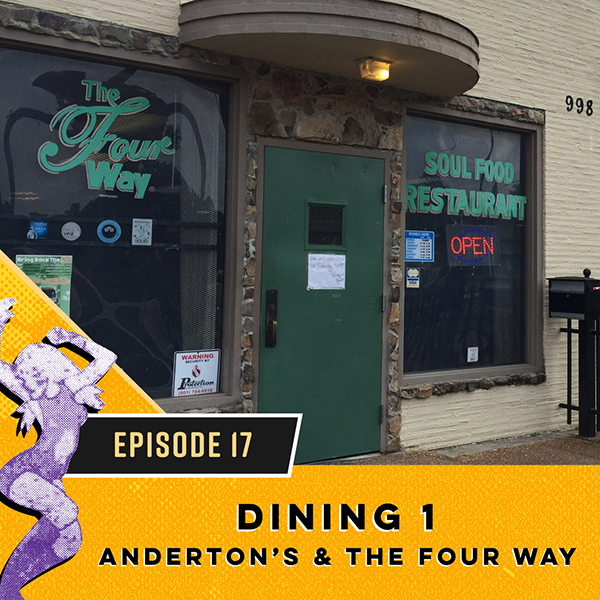
Sunday Sep 24, 2017
Dining 1: Anderton's & The Four Way
Sunday Sep 24, 2017
Sunday Sep 24, 2017
In this episode of Memphis Type History: The Podcast, Caitlin and Rebecca tell each other about a restaurant from Memphis history. Caitlin starts us off with some old timey vocabulary before diving into Anderton's (get it??) Rebecca follows up with charming stories of The Four Way, which is so near and dear to our hearts.
Herbert Anderton learned how to cook on a Texas Army base before bringing his skills to downtown Memphis.
In 1945, Anderton's Restaurant and Oyster Bar opened at 51 Madison to immediate success. In 1956, Anderton's East opened up in the former Gilmore Seafood Restaurant at 1901 Madison as a second location. There was also a third location around 1965 in Whitehaven, across from Graceland. Then it and the original downtown location closed, and Anderton's East became the only one – and this is the one that most people have such fond memories of... due in part to its amazing piratey, nautical-themed interior.
In the restaurant’s first ten years, it served over six million oysters to more than two million diners. On their 10-year anniversary, they baked a cake to serve 2,500 customers so that anyone who came in on that day could enjoy a slice. If you have a photo or memory of this event, please get in touch with us. We need to hear more about this event!
Anderton's closed in 2005 and was demolished in 2009 BUT the décor lives on at The Cove on Broad Avenue.
It began as a small pool hall where you could also get basics like a hotdog, a sandwich, or a beer. In 1946, Clint and Irene Cleaves took out a loan on their house to purchase the building. Their restaurant had an upscale feel with white tablecloths and snazzy servers. They added a private dining room in the back complete with a doorbell and required staff approval before entry.
The Four Way was one of the few places in Memphis that white and black people ate at together. Martin Luther King, Jr., was a regular, as were many famous Stax recording artists. And, of course, Elvis also dined there.
The restaurant closed in 1996 due to Mrs. Cleaves' declining health. Willie Earl Bates purchased it when it went up for auction in 2001. He remodeled it and expanded dining space by removing the pool tables and adding an upstairs dining room for groups. But he did keep the menu as close to the original Cleaves' version as possible, even having cooks help with taste-testing to make sure the food remained "rightly seasoned."
Today you can still find amazing soul food at The Four Way, as it carries on even after Mr. Bates' passing in 2016.
For full show notes, go to memphistypehistory.com/dining1
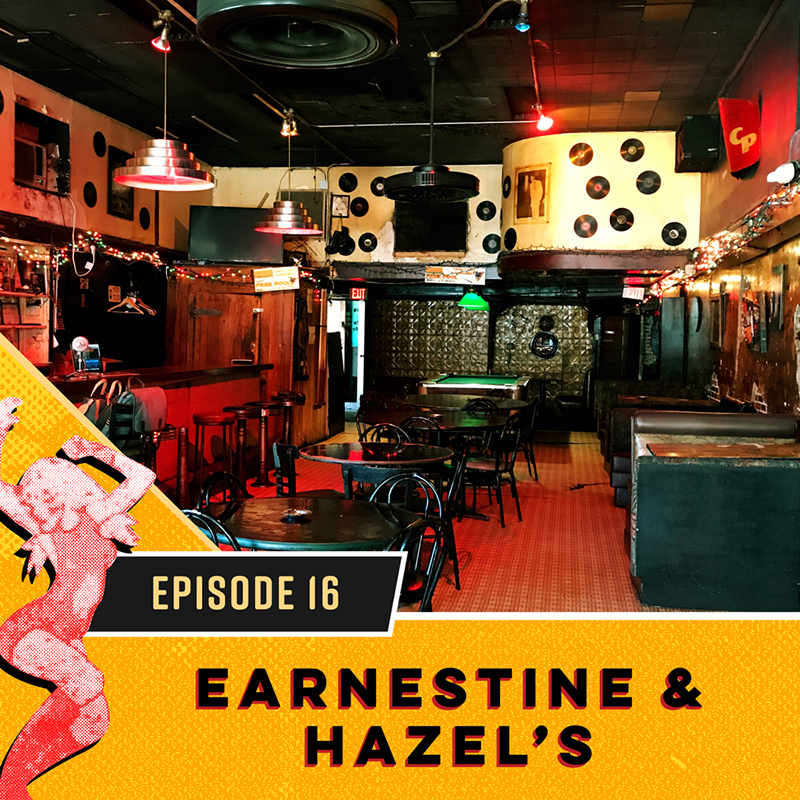
Sunday Sep 17, 2017
Earnestine and Hazel's
Sunday Sep 17, 2017
Sunday Sep 17, 2017
In this episode of Memphis Type History: The Podcast, Rebecca and Caitlin visit Memphis' favorite historical dive bar, Earnestine and Hazel's. They pull up a stool and hear what soul burger cooker and bartender Clarence has to tell about E&H. They also take a tour of the bar and then wrap up by dancing the morning away with sounds of a haunted jukebox.
Earnestine & Hazel's began it's life as a church in the late 1800s.
However, the building at 351 South Main Street in downtown Memphis then became a dry goods store. And then it was a pharmacy owned by Abe Plough of Coppertone fame. He became a multi-millionaire so he sold the business to the two sisters who ran a hair salon upstairs (while also living there): Earnestine Mitchell and Hazel Jones.
Upstairs the hair salon remained, with additional rooms being rented out to ladies of the night. The downstairs flipped over to a jazz night club run by Earnestine's husband, Sunbeam. He was a local music producer and promoted, and had opened Club Paradise over near Stax Records – so he knew a lot of famous musicians – and they would often come down to his wife's café for general frolicking late into the night. Ray Charles was apparently a regular.
But by the end of the '70s, Stax was gone and with it, Club Paradise. The whole brothel aspect limited the café's customer base. By the '90s, Earnestine and Hazel were looking for a way out.
As a ten-year-old, Russell George competed in the James Brown Dance Contest at the Mid-South Coliseum. Brown himself awarded this only white boy in the competition first prize. Five years later, George was running an illegal bar out of his apartment called Jefferson in the Rear. As a young man, he played a part in making Murphy’s Oyster Bar happen and became The Memphis Icebreaks' band manage (and also was one of their dancers). In 1992, he bought the brothel, invented the Soul Burger, and the rest, shall we say, is Memphis dive bar history.
Russell George tragically died in 2013 of a self-inflicted gunshot wound after battling cancer and depression. At 62, he was the thirteenth person to move into the next world at E&H.
His Soul Burger has fed the souls of so many throughout the years, and Clarence continues to serve them up from the same griddle Earnestine and Hazel used back in the combo café/brothel days. On a hot day in June, Rebecca and Caitlin sat down to chat with Clarence about the history of E&H.
You can follow along with the full show notes at memphistypehistory.com/eh
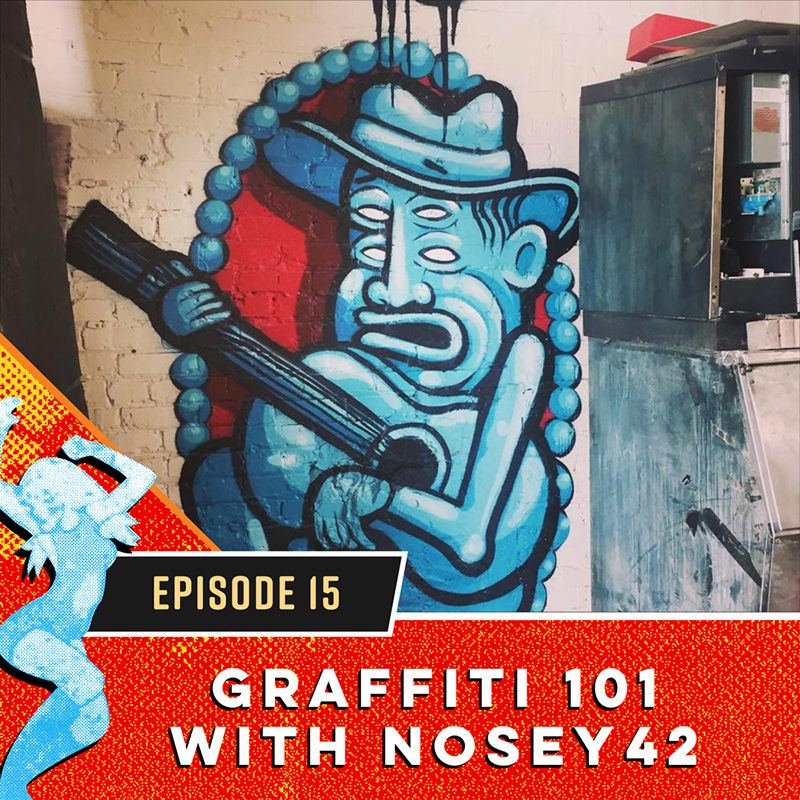
Sunday Sep 10, 2017
Graffiti 101 with Nosey42
Sunday Sep 10, 2017
Sunday Sep 10, 2017
In this episode of Memphis Type History: The Podcast, Rebecca sits on her front porch with graffiti artist Brandon Marshall sipping on mojitos while he takes us all the way back to the beginning of his art form and its manifestations in our beloved Memphis. Do you know the difference between graffiti and a mural? Sit up straight, class is in session.
Forgive the ambient noise, we actually did record on my front porch and so you hear the crickets outside and the occasional car or plane passing by.
This whole conversation was framed by Rebecca's questions and lack of knowledge on the subject, so they started at the beginning. How did graffiti start? While the exact city is somewhat unclear, the big northeastern cities are definitely all a part of the roots of graffiti. New York, DC, Philadelphia, all had very active scenes in the seventies. At its core, graffiti started as kids just wanting to leave something behind. So they would tag their name on subways, alleys, wherever they could. Then, it escalated. With everyone tagging their name, it became really important to set yourself apart. How do you do that? Two ways—location and artistry. You wanted to make it stood out by putting your tag someplace really visually accessible to lots of people. You also wanted to make sure you added some flare to that tag so people realized it was you as they saw it in more and more high-profile places. A couple of other things worth noting: named derived first the the city street number and your crew name. Crews are basically people teaming up and they share a piece of your tag name. So Nosey42 is Brandon's nickname and his crew, 42. What is a crew and how do you get into one? How many does Memphis have? Hear more about that in our conversation on the podcast.
Even though, we are talking about something that is done mostly illegally, it turns out there is a bit of a code or an etiquette. If you cover someone else's tag it has to follow one basic guidelines: it has to make the work objectively better. There's more to it than that, but basically that's what it comes down to. There have been fights over this and maybe even worse. Brandon also told us about some of his experiences dealing with instances of people breaking the graffiti code.
Brandon tells us that when being considered, a crew will take note of the quality of an artist's work and the quantity. Just like he mentioned in the history, they want to have artists whose work can be seen in the most high profile places, and is at a high level. This lead us into a discussion about the place of murals and where he saw them in the landscape of the art community in the world broadly but also specifically in Memphis. He was quoted in a previous article speaking the appeal of popular art like murals. In other words, he loves art that anyone can see and enjoy, and see meaning in. He even went so far as to say the truest form of graffiti, tagging your name on a wall, is really the most boiled down, pure, honest, form of art. All you need is a name and spray can to do it and even less to appreciate it of what it is. That's why we love talking about graffiti, because at our core, we're about type being used in Memphis.
So what does Brandon think about the prevalence of murals on walls across Memphis, even in some of the newest, hippest, developments in the city? As you might expect, he has mixed feelings.
For full show notes go to memphistypehistory.com/graffiti

Wednesday Sep 06, 2017
Bonus Episode: Riding Elephants
Wednesday Sep 06, 2017
Wednesday Sep 06, 2017
Tune in to Memphis Type History's very first Speakpipe message sent by Lisa Bryant from Little Rock, Arkansas. Hear a particular memory she has of the no longer existing Raleigh Springs Mall.
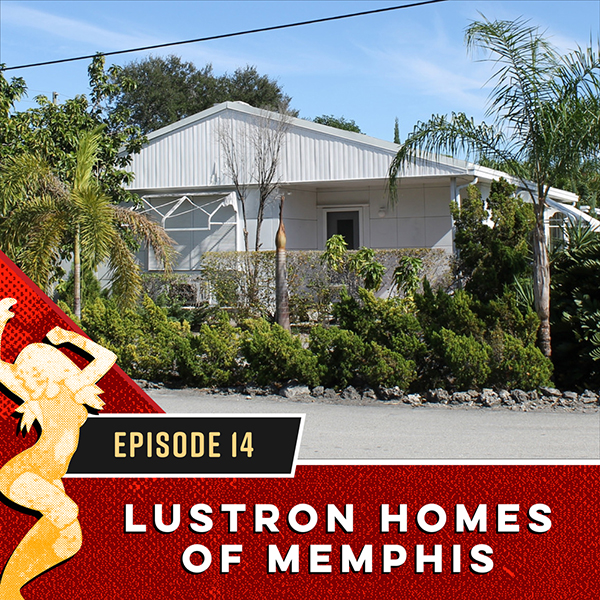
Sunday Aug 27, 2017
Lustron Homes of Memphis
Sunday Aug 27, 2017
Sunday Aug 27, 2017
In this episode of Memphis Type History: The Podcast, Caitlin tells Rebecca all about the engineering and architectural marvel that was the Lustron home. Three of these rare postwar gems can be found in Memphis.
Carl Strandlund invented the Lustron home to answer the need for affordable housing for soldiers returning from World War II. The plan was that the government would provide the steel and Strandlund would combat the housing shortage with these highly unique, prefabricated, enamel-coated, modular steel homes.
In 1946, he demonstrated the prototype which he claimed was fireproof (because steel), and also could do not rust or be damaged termites or rats and such. It could also stand up to water and sun damage of all kinds. Finally, homeowners would never have to paint it, replace the roof, or do anything more than grab a hose when it was time to clean it. In 1947, his manufacturing company was ready to do business, armed with the first ever venture capital loan from the U.S. government.
These homes that could "defy weather, wear, and time" were designed for the modern family, with ads claiming a "new and richer experience for the entire family." At $8,500–$9,500, the pricing came in at 25% less than the market average (although prices went up by 1949 to $10,500). There were three models to choose from and each came with two- and three-bedroom options. The most popular selection was the 1,021 square foot, two bedroom Westchester Deluxe.
Unlike the current models of prefabricated homes one purchased from Alladin, Gordon-Van Tine, Montgomery Ward, or Sears at this time, Lustron homes were delivered as engineering marvels complete with a new kind of steel framing system of vertical steel studs and roof-ceiling trusses that the interior and exterior panels were then attached to... and the interior came ready to assemble as well, with all counter tops, pocket doors, and many pieces of furniture built into the design for space-saving. Customers had the option add-on of a combination clothes- and dish-washer made by Thor.
The manufacturing system was also a marvel – of the assembly line kind. The Ohio-based factory featured eight miles of conveyor belts, eleven 180-foot enameling furnaces, and up to 1,000 bathtubs could be made in one day, each in a single draw from the press. The finished pieces were all modular, so once the custom-designed trucks arrived on site, the 33,000 individual parts could be built into a house within three days.
You might be wondering why, with all of these benefits to their name, Lustron homes are such rare historical and architectural gems. Due to lots of governement bureucracy adn soem sneaky stuff (check out the links roundup at the end of this post if you want all the gory details), the Lustron factory just never produced at capacity. Rather than the 15,000 homes they were projected to make in 1947 and the 30,000 that were planned in 1948, only 2,498 were ever made at all – and Memphis got four of them!
Only about 2,000 still exist in the U.S., and most have been modified (somewhat extensively, in many cases). The original owners of the Memphis Lustron homes would have ordered them at the Mid-South Fair. As far as we know, three are still in the city and we discuss them on the show.
For full show notes go to memphistypehistory.com/lustron

